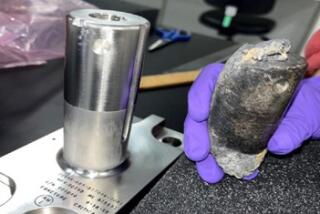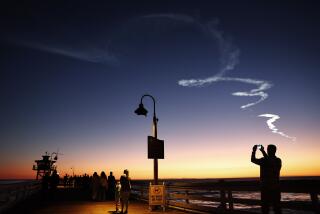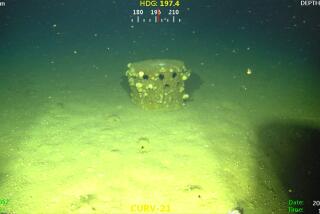Fearing Collisions in Space, U.S. Tracks Orbiting Debris : Science: With 7,000 pieces of ‘junk’ circling Earth, some say a disaster for manned craft is virtual certainty.
CHEYENNE MOUNTAIN, Colo. — Deep in the bowels of this Rocky Mountain granite fortress, in a windowless room full of color computers with large, round display screens, military men and women are working around the clock to prevent what many fear is the next lurking space disaster: a cataclysmic collision between a manned spacecraft and space debris.
The U.S. Space Surveillance Network, originally designed to serve as an early-warning system against missile attacks, now devotes much of its time and resources to tracking 7,000 chunks of orbiting space debris that increasingly threaten astronauts and spacecraft, including sensitive military intelligence-gathering satellites.
But with about 240 new pieces of junk to track each year--plus untold numbers of smaller but equally dangerous pieces of undetectable debris--some fear that catastrophe is only around the corner.
Fueled by such concern, space-faring nations are racing to develop new technologies to track debris before disaster strikes. There is even talk of sending Gargantuan balloons filled with foam to sweep up space junk, which range in size from paint flecks to nuts and bolts to huge chunks of rocket parts.
Otherwise, such debris “could render some well-used low-Earth orbits too risky to use” by the year 2000, the congressional Office of Technology Assessment warns.
“We could end up imprisoned on this planet by our own hands,” adds John E. Pike, a leading private space analyst.
Given present conditions, “harmful collisions with spacecraft would be virtually ensured” in the next decade or two, predicts Ray A. Williamson, a space debris expert with the Office of Technology Assessment.
Such a catastrophic scenario was nearly played out twice this autumn when the Space Surveillance Network had to warn two consecutive space shuttle crews of impending danger, which was averted when the shuttles maneuvered out of harm’s way.
During the first decade of the shuttle program, beginning in 1981, no orbiter had to dodge debris.
“Thirty years ago, you could go up there and drive around and not worry. But no more,” says Pike, director for space policy at the Washington-based American Federation of Scientists. “Now the surveillance network is doing a brisk business, engaged in traffic management.”
Debris is generated when spacecraft are released from the upper stages of rockets and when lens covers, clamps, astronaut gloves, cameras and other incidental hardware are jettisoned.
Some pieces of debris are downright massive, like the 3,200-pound Soviet rocket remnant that lurked in the path of Atlantis late last month.
But they are far outnumbered by some 70,000 much smaller but also potentially lethal objects that cannot now be detected, such as paint chips--”the most serious hazard to space operations,” says Williamson.
“These tiny objects can wreak considerable havoc by scouring or contaminating sensitive surfaces and instruments,” he notes. “They also may be capable of piercing current spacesuits of astronauts working outside their spacecraft.”
“We just don’t have a handle on that stuff at all,” adds Pike.
Of the two dozen spacecraft that have unexpectedly broken apart, at least one has been linked to a collision with debris--the unmanned Soviet Cosmos 1275, which fragmented in 1981.
And a U.S. research satellite, Pageos 1, is listed as a “possible” collision victim. It broke apart in July, 1975, a decade after launch.
The most recent close encounter occurred during the flight of the Atlantis in November.
But after being warned by officials here, commander Frederick Gregory simply charted a new course. Otherwise the Atlantis would have been traveling a mere three miles behind the Cosmos booster.
“There will be more frequency of avoidance maneuvers--probably getting to where one is required once every other mission or so,” a National Aeronautics and Space Administration scientist conceded after the mission.
The shuttle Discovery in mid-September also had to dodge a piece of debris.
In space, where everything travels at a speed of 17,000 m.p.h., even minuscule objects can cause considerable damage.
A chilling reminder of that occurred in 1983 when a tiny paint chip--the size of a grain of salt--struck the space shuttle Challenger. It gouged a deep pit in the orbiter’s windshield.
Although the damage posed no immediate danger, the window was weakened beyond the allowable safety limit for flight and had to be replaced.
“Some things are just too small for us to see,” acknowledges Air Force Col. Michael Ingelido, chief of space control operations for the Space Surveillance Network.
Debris poses a special hazard for long-term orbiting spacecraft such as the Hubble Space Telescope, which was launched in 1990. It stands a one-in-100 chance of being seriously damaged by space waste during its 17-year life expectancy, says Williamson, who directed the 1990 OTA congressional study.
Unlike natural meteoroids, which pass through near-Earth space in a matter of a few minutes, debris may continue to orbit the planet for centuries.
Man-made objects re-enter the Earth’s atmosphere on an average of more than one a day, but most do not survive the fiery plunge to strike the planet.
Since the Soviet Union launched Sputnik I in 1957, more than 3,800 payloads have been sent into orbit, and the surveillance network has tracked some 21,800 objects, all but 7% of those being debris. Two-thirds of the detectable debris has decayed or “de-orbited,” officials say.
In all, more than 100 spacecraft have fragmented while in orbit, including at least 12 satellites deliberated destroyed by the United States and the Soviet Union during weapons testing, records show. Each spacecraft breakup can generate hundreds of detectable pieces of debris.
The worst-case scenario is a chain reaction in which debris proliferates as collisions generate more and more debris--resulting in an expanding “cloud” that forms a band around Earth.
The critical mass to sustain such a cataclysmic reaction could be reached within 20 to 50 years, according to some mathematical models.
It is the job of the Space Surveillance Network to prevent that from happening.
Located 1,800 feet deep inside Cheyenne Mountain, high above Colorado Springs, the network shares the vast underground facility with other national defense installations, such as NORAD (North American Aerospace Defense Command).
Relying on a computerized worldwide network of 26 radars, telescopes, cameras and radio receivers, trackers can keep constant watch on the 7,000 orbiting objects, charting their present and future courses with great accuracy.
During shuttle missions, “we provide collision avoidance support,” says Navy Lt. James Thilenius, the network’s orbital space officer.
Playing it conservatively, the network alerts NASA whenever any approaching object is expected to come within an imaginary, football-shaped region of the orbiter, an area measuring roughly 15 miles by 3 miles by 3 miles. And it strives to provide such warnings with at least eight hours’ notice.
But Thilenius and other network officials concede that the current system has gaps.
The optical sensors can only be used during daylight hours and are subject to various meteorological conditions, says Navy Capt. Andy Cain. And conventional radar beams are too narrow to search large areas of deep space simultaneously.
But the biggest drawback remains the inability to detect small pieces of debris. NASA and the Pentagon now are developing powerful new radars that can detect and catalogue such small objects.
But eventually a space-based tracking system, using optical and infrared monitors, perhaps deployed on the planned space station, may be necessary, says Darren S. McKnight, a space debris expert in Alexandria, Va.
A valuable source of information on small debris is the Long Duration Exposure Facility (LDEF), which orbited Earth for nearly six years until its retrieval last year. Scientists have been studying its test panels since.
Their findings will have special relevance to the space station Freedom, which could be launched around the turn of the century, because it is to be placed in a similar orbit as the LDEF.
The space station also is to be assembled in orbit, requiring astronauts to spend perhaps hundreds of hours working in space, making them even more vulnerable to the tiniest debris.
Even when assembled, the Capitol-sized space station will not be able to maneuver as easily as the shuttle can, Williamson says.
During its anticipated 30-year life span, the space station is to house hundreds of astronauts while serving as a transportation vehicle and service depot in launching cargo and crew to the moon and Mars.
“The longer your exposure, eventually your number’s going to come up,” warns Pike.
Perhaps the greatest danger in the event of a collision between the space station and debris is the potential for massive fuel tanks to explode, experts say.
“Even if a fuel depot were located several hundred kilometers from the space station, such an explosion would cause debris to spread rapidly to Freedom, placing at risk the entire facility and crews in it,” Williamson and McKnight wrote in their OTA study last year.
The United States has taken the lead in adopting measures to minimize the proliferation of new debris. In 1981, NASA began using a new method to vent propellants from the upper stages of Delta rockets after they deliver payloads into orbit.
That has minimized the chances that the discarded rockets will eventually explode. Previously, seven upper-stage Delta rockets--one of NASA’s major launch systems--exploded, scattering untold pieces of debris in space.
NASA also has added electrical protection circuits to batteries on board spacecraft to prevent shorts, which can cause battery explosions.
Mother Nature also is lending a helping hand in eliminating some of the space debris, says Thilenius. Because of increased solar activities in recent years, the upper atmosphere has become more dense, thus increasing drag on debris and causing some of it to fall out of orbit, presumably burning up before reaching the Earth’s surface.
NASA also hopes to prevent inactive payloads and spent rocket-propulsion stages from breaking up by propelling them back toward the Earth.
But McKnight, Williamson and others say researchers also must develop new designs and lightweight materials to further minimize damage caused by debris, especially with the space station in mind.
In addition, they say, cost-effective ways must be found to remove existing debris, perhaps by using tethers or gigantic balloon-like devices to collect them. But these approaches would necessarily put astronauts in dangerous proximity to the problems they are trying to eliminate.
And beyond technological and financial barriers, efforts to remove debris are further hampered by current international laws, which forbid the interference with space objects belonging to another nation.
But such questions are of little concern to those who toil with a can-do attitude inside the 4 1/2-acre, underground fortress that is home to the Space Surveillance Network.
“Space debris is something that we should do all we can to reduce,” says Ingelido. “But in terms of being overly concerned, I’d say no. Debris is a known risk to space operation.”






